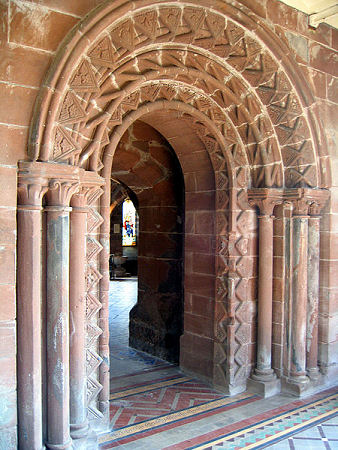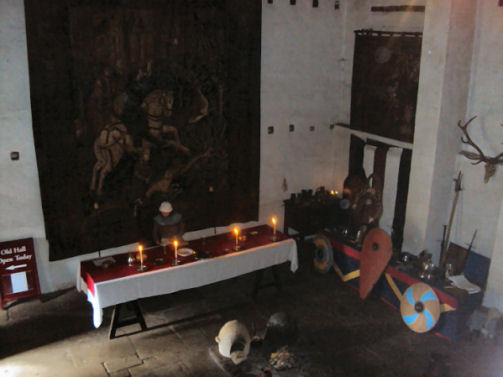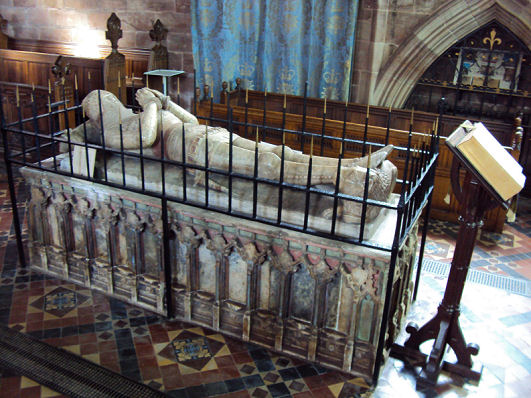Medieval Cheshire
 Following the Norman conquest of 1066, King William I confiscated most of lands of the Saxon lords to reward his Norman followers for their support at Hastings. This resulted in ill feeling, resentment and dissent amongst the Anglo-Saxon population and Cheshire and the north of England accordingly provided William the Conqueror with stiff resistance.
Following the Norman conquest of 1066, King William I confiscated most of lands of the Saxon lords to reward his Norman followers for their support at Hastings. This resulted in ill feeling, resentment and dissent amongst the Anglo-Saxon population and Cheshire and the north of England accordingly provided William the Conqueror with stiff resistance.
This led England's new Norman king to treat the north with brutality and severity in the 'harrying of the north', land and villages were sacked and destroyed and much land in Cheshire was laid waste. In 1069 the property of the Saxon Earl Edwin of Mercia, the brother-in-law of the last Saxon king, Harald, as well as that of other Anglo-Saxon lords was siezed by William after he joined a Saxon rebellion. Earl Edwin who had fought at the Battle of Stamford Bridge but had arrived too late to participate in the Battle of Hastings, he rebelled for a second time against William in 1071, but was betrayed by Normans in his retinue and killed.
The Domesday Book of 1086 aptly describes the devastation which was wreaked on Cheshire were much of the land there is recorded as 'wasta', or wasteland. In 1070 the city of Chester was besieged and sacked. A castle was then founded at Chester and the old Roman city walls were repaired. Chester was the last Saxon burgh to fall during William's subjugation of northern England, during the final stages of the Harrying of the North in 1069-70, half the Saxon houses in the city were pulled down to accommodate the building of Chester Castle.
Further Castles were built throughout Cheshire among these were Frodsham Castle, once situated at the foot of Overton Hill in Frodsham. Halton Castle overlooking the estuary of the River Mersey, the first timber castle to occupy the site was later replaced by the current stone structure in the 12th century and Shotwick Castle, which overlooked the Dee Estuary.
William went on to abolish the Anglo-Saxon Earldom of Mercia and created a new Earldom of Chester. William made Hugh d'Avranches, first Earl of Chester. Hugh, William's half-nephew, was given the nickname Lupus, meaning the Wolf, on account of his savage ferocity. Cheshire continued to be ruled by Hugh's descendabnts until in 1237, the family became extinct in the male line when the 7th Earl, John the Scot, died without a son to suceed him. King Henry III then took the title and earldom for his eldest son, Prince Edward, who was later to become King Edward I. Ever since then the eldest son of each succesive English monarch has held the title of Earl of Chester.
Medieval Cheshire- what to see and where
The Agricola Tower at Chester Castle, the three-storeyed gate tower of the castle dates to the late twelfth century. On its first floor, situated above the entrance passage, is the chapel of St Mary de Castro. The chapel contains items of Norman architecture. Wall paintings which are said to date from around 1220 were revealed when the layers of internal whitewash were removed in the 1980s.
 Beeston Castle dating from 1225, was founded by Ranulf, the sixth Earl of Chester (1170-1232), following his return from the Fifth Crusade. In medieval documents the castle is referred to as 'Castellum de Rupe', the Castle on the Rock.The outer bailey was roughly rectangular in shape, with 6 feet (2 metre) thick walls. The walls, sections of which still remain today, contain a number of D-shaped towers, an innovation in English castles at that time. The inner bailey was situated on the rocky summit at the western end of the crag.
Beeston Castle dating from 1225, was founded by Ranulf, the sixth Earl of Chester (1170-1232), following his return from the Fifth Crusade. In medieval documents the castle is referred to as 'Castellum de Rupe', the Castle on the Rock.The outer bailey was roughly rectangular in shape, with 6 feet (2 metre) thick walls. The walls, sections of which still remain today, contain a number of D-shaped towers, an innovation in English castles at that time. The inner bailey was situated on the rocky summit at the western end of the crag.
Tatton Old Hall (pictured right) on the beautiful Tatton Park estate was built as a manor house in the early fifteenth century by either the Stanley family or by Sir Richard Brereton. The hall stands near to the site of the now disappeared village of Tatton, the site of which is now just about discernable by the humps and hollows in the ground.
Little Morton Hall is a superb example of a half timbered building and dates from the late fifteenth century. Little Moreton Hall belonged to the de Moreton family, who had occupied the site since the thirteenth century. The highly irregular building rambles around three sides of a characterful cobbled courtyard. The great hall dates from around 1450. the kitchen wing, which stands adjacent, was added in about 1480, the entire complex is surrounded by a defensive moat.
The Old Dee Bridge at Chester carries the road which leads from the bottom of Lower Bridge Street to Handbridge. The Romans built the first brige crossing the Dee in this site, the present red sandstone, seven arched structure is medieval and so legend has it, was built on the orders of Edward I. Farndon Bridge also dates to the medieval period, crosses the river Dee and which separates Farndon and the village of Holt. The nearby remains of medieval Holt Castle which lie just on the Welsh-Cheshire border, date to the thirteenth century and were constructed during the Welsh Wars of King Edward I. The five-towered fortress was once known as Castrum Leonis or Castle Lyons.
Majestic Chester Cathedral a red sandstone, Grade I listed building,is one of Chester's main tourist attractions. Following the Norman Conquest, in 1093 a Benedictine monastery was established on the site by Hugh Lupus, 'the Wolf', Earl of Chester, and Ermetrude, his wife, transformed the building into a grand Benedictine monastery, assisted by Anselm, who later became Archbishop of Canterbury. The earliest surviving parts of the present structure date from that time. The first part of the cloisters to be built was the south side followed by the west, north and east sides. The final part to be constructed was the Chapter House, completed in about 1250. The abbey church, beginning with the Lady Chapel at the eastern end, was extensively rebuilt in Gothic style during the thirteenth and fourteenth centuries. The superbly carved woodwork in the quire dates from 1380.
 Norton Priory was a priory and later an abbey, established as an Augustinian foundation by William Fitz Nigel, 2nd Baron of Halton in the twelfth century. The undercroft is all that now remains of the original buildings, (with a Victorian addition) but the foundations of the abbey and the monastery are clearly visible. The walled garden at the priory contains a medieval herb garden.
Norton Priory was a priory and later an abbey, established as an Augustinian foundation by William Fitz Nigel, 2nd Baron of Halton in the twelfth century. The undercroft is all that now remains of the original buildings, (with a Victorian addition) but the foundations of the abbey and the monastery are clearly visible. The walled garden at the priory contains a medieval herb garden.
Ince Manor, a former monastic grange, is situated on Marsh Lane in the village of Ince. The manor, which is a Grade I scheduled monument, is one of the earliest recorded properties of the Bendictine Abbey of St Werburgh in Chester. It was given to the Abbot and monks in 1093 by Hugh Lupus, Earl of Chester, the nephew of William the Conqueror. King Edward I is known to have stayed at the manor in August, 1277.
Other examples of fine ecclesiastical medieval architecture in Cheshire include the Church of St. Mary at Astbury, one of the best churches in Cheshire . The yellow sandstone chancel is of Norman origin, whilst most of the building dates back to the fourteenth and fifteenth centuries. The millstone grit tower was constructed towards the end of the thirteenth century. The medieval canopied Venables tomb lies in the churchyard.
The red sandstone St Mary's Church at Nantwich, which is of fourteenth century origin, is know locally as the 'Cathedral of South Cheshire'. Built on the grand scale with an octagonal tower it has significant features in common with the cathedrals at Lichfield, Chester, Gloucester and Wells. Interesting features of the church's interior include the fourteenth century lierne-vaulted ceiling of the choir, the carved stone canopies of the sedilia in the chancel, and the exquisite and intricately carved wooden canopies over the choirstalls. The church boasts twenty late fourteenth century misericords with a variety of weird and wonderful carvings.
The medieval church of St. Boniface at Bunbury, was included by Alec Clifton-Taylor in his list of 'best' English parish churches, stands above the River Gowy and was rebuilt in the decorated style in 1320, the effigy of Sir Hugh Calverley, companion-in-arms to Edwaed, the Black Prince, (pictured left) which lies in the churches chancel, is the earliest surviving alabaster effigy in Cheshire.
The church of St James and St Paul, at Marton, was founded in 1343 by local landowner Sir John de Davenport and his son Vivian and is undoubtedly one of the finest examples of the Medieval wooden church remaining in England today, architectural historian Nickolaus Pevsner referred to Marton church 'one of the architectural gems of Cheshire'. The original structure has remained untouched apart from a sympathetic Victorian restoration, when some of the windows were altered, the timbers in the tower tidied and the existing west entrance was added.
The Vernon family of Cheshire and Derbyshire
